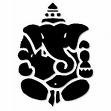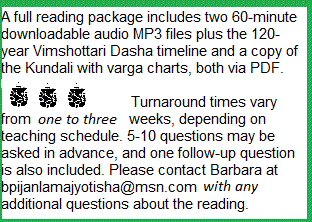

Brihat Parashara Hora Shastra
sarga 27, shloka-1-40
Evaluation of
बल
bala
= value
Balancing-Weights
Strengths
This page in progress, please check back
[Begin Direct Quotation]
" Shad Bala consists of the following:
- sthāna Bala (positional)
- Dig Bala
[dikbala] (directional)
- Cheshta Bala (motional)
- Kaala Bala (Temporal), inclusive of Ayana Bala (equinoctial)
- Naisargika Bala (natural)
- Drika Bala (aspectual)
sthāna Bala comprises the following considerations:
- Uttama Bala (exaltation),
- Sapta Vargaja Bala (strength accruing out of positions in Rashi, Hora, dreshkamsha, saptamsha, navamsha , dvadashamamsha -10 and Trimshamsha),
- Ojhayugma Rashi amsha Bala (acquired by placement in odd, or even Rashi and in odd, or even Navamsha),
- Kendradi Bala (due to placement in Kona, or Panaphara, or Apoklima Bhava),
- Dreshkamsha Bala (due to placement in first, second, or third decanate of a Rashi ).
- Kaala Bala comprises of the following subdivisions:
- Nathonnata Bala (diurnal and nocturnal),
- Paksha Bala (fortnight),
- Tribhaga Bala (due to day/night being made in 3 parts),
- Varsha, maasa, dina and Hora Bala (Varsha - astrological year, maas a- month, dina - weekday and Hora - planetary
- hour),
- Ayana Bala (equinoctial),
- Yudhdha Bala (due to partaking in war between Graha).
1-1½. sthāna Bala (up to Sloka 6).
Firstly Uttama Bala .
Now about the strengths by classes positional, temporal etc.
- Deduct from the longitude of the Graha its (deep) debilitation point.
- If the sum is less than 6 Rashi s, consider it, as it is; if it exceeds 6 Rashi s, deduct the same from 12 Rashi s.
- The sum so got be converted into degrees etc. and divided by 3, which is the Graha's Uttama Bala in Virupas.
2-4.Sapta Vargaja Bala .
If a Graha is in its Mooltrikona Rashi, it gets 45 Virupa,
-
in Svastha Rashi 30 Virupas,
-
in Pramudit Rashi 20 Virupa,
-
in Shanta Rashi 15 Virupa,
-
in Dina Rashi 10 Virupa,
-
in Duhkhita Rashi 4 Virupa
-
and in Khala Rashi 2 Virupas.
-
Similarly these values occur for the other 6 divisional occupations, viz. Hora, dreshkamsha, Saptamsha, Navamsha, Dvadashamamsha -10 and Trimshamsha.
When all these are added together the Graha's Sapta Vargaja Bala emerges.
4½. Ojha-yugma Rashi Amsha Bala .
Each of Shukra and Chandra in even Rashi and others in odd Rashi acquire a quarter of Rupa.
-
These are applicable to such Navamsha also.
5. Kendradi Bala .
A Graha in a Kona gets full strength,
Male, female and hermaphrodite Graha, respectively, get a quarter Rupa according to placements in the first, second and third decanates.
7-7½. dikbala
Deduct Bandhu Bhava (Nadir) from the longitudes of Surya and Mangala, Yuvati Bhava from that of Guru and Budha, karma-bhava from that of Shukra and Chandra and lastly Lagna from that of Shani.
-
If the sum is above 180 degrees, deduct the sum from 360.
-
The sum arrived in either way be divided by 3, which will be dikbala of the Graha.
Firstly Nathonnata Bala .
- Find out the difference between midnight and the apparent birth time, which is called Unnata.
- Deduct Unnata from 30 Ghatis to obtain Nata.
- Double the Nata in Ghatis, which will indicate identical Nata Bala for Chandra, mangala and Shani.
- Deduct the Nata from 60 to know the Unnata Bala of Surya, Guru and Shukra.
- Budha, irrespective of day and night, gets full Nathonnata Bala .
10-11. Paksha Bala .
-
Deduct from Chandra's longitude that of Surya. If the sum exceeds 6 Rashi s, deduct the same from 12.
The product so obtained be converted into degrees etc. and divided by 3, which will indicate the Paksha Bala of each of the benefic Graha.
The Paksha Bala of benefic should be deducted from 60, which will go to each malefic, as Paksha Bala .
12. Tribagha Bala .
-
One Rupa is obtained by Budha in the first 1/3 part of day time, by Surya in the second 1/3 part of the day and by Shani in the last 1/3 part of the day.
-
Similarly Chandra, shukra and Mangala get full Bala in the first, second and last 1/3 parts of the night.
-
Guru gets this Bala at all times.
13. Varsha-Maas-Dina-Hora Bala .
-
15, 30, 45 and 60 Virupas are in order given to Varsha Lord, maas Lord, dina Lord and Hora Lord.
-
Naisargika Bala has already been explained.
-
The Varsha Lord is the ruler of the day, on which the astrological year of birth starts.
-
To calculate this we first need the number of ay , past from the beginning of Creation, the Ahargana .
[Translator's Notes.
According to late Rev. Ebenezer Burgess, who translated Surya Siddhanta into English, as on January 1, 1860, the number of days, past from the beginning of Creation are 714,404,108,573. Divide the number of days, past from the day of Creation till the day of birth, by 60. Reject remainder and multiply the quotient by 3. Increase the post-multiplied product by 1 and divide by 7. The remainder will indicate the week day, on which the astrological year, giving birth to the native, opened. Remainder 1 indicates Sunday, 2 Monday and so on.]
Maasa Lord.
- Divide the same Ahargan by 30 and the quotient indicates months, passed from Creation to birth.
- The completed months be multiplied by 2 and increased by 1.
- The latter sum should be divided by 7 and the remainder indicates, on which day the birth month began.
- Continuing with the same case, we divide 65295 by 30. Quotient is 2176.
- This sum multiplied by 2 and increased by 1 denotes 4353.
- Dividing 4353 by 7, we get a remainder of 6, denoting Friday.
- That is, the month of birth began on Friday and the Maas Bala goes to Shukra, the ruler of Friday.
Dina Lord.
- Though the week day of birth can be known from ephemeris, or perpetual calendars, we better adopt the method prescribed, which will confirm, if the Ahargan followed is correct.
- The number of days, as arrived above, indicating Ahargan, be divided by 7 and the remainder will indicate the week day of birth.
Hora Bala .
- Hora means planetary hour.
- Each day from sunrise to sunrise is divided into 24 equal parts of one hour.
- These Horas are ruled by the 7 Graha from Surya to Shani.
- The first Hora of the day is ruled by the Lord of the week day.
- The 2nd one is ruled by the Lord of the 6th week day, counted from the first ruler.
- The 3rd Hora is ruled by the Lord of the 6th week day, counted from the 2nd Hora Lord.
- Similarly it proceeds in the same manner, till the first Hora of the next day is taken over by the Lord of that day himself.
- Whichever Graha rules the birth Hora, gets the Hora Bala .
- Horas are to be calculated for mean local time and not standard time of births.
14. Naisargika Bala .
- Divide one Rupa by 7 and multiply the resultant product by 1 to 7 separately, which will indicate the Naisargika Bala, due to Shani, mangala, budha, Guru, shukra, chandra and Surya, respectively.
15-17. Ayana Bala .
- 45, 33 and 12 are the Khandas for calculating Ayana Bala .
- Add Ayanaamsha to the Graha and find out the Bhuja (distance from the nearest equinox).
- Add the figure, corresponding to the Rashi (of the Bhuja) to the Bhuja.
- The degrees etc. Of the Bhuja should be multiplied by the figure, corresponding to the highest of the left out Khandas and divided by 30.
- Add the resultant product to the sum, obtained earlier.
- Convert this to Rashi, degrees, minutes and seconds.
- If Chandra and Shani are in Tula, or ahead, add to this 3 Rashi s and, if in Mesha to Kanya, reduce from this 3 Rashi.
- Similarly it is reverse for Surya, mangala, shukra and Guru.
- For Budha 3 Rashi s are always additive.
- The resultant sum in Rashi, degrees and minutes be divided by 3 to get the Ayana Bala in Rupas.
[Translator's Notes.
-
Ayana Bala can be found out on the following simple formula: Ayana Bala = 60*(23°27'+ Kranti)/(46°54') = (23°27'± Kranti)*1.2793. The following points have to be remembered in respect of Krantis. When Chandra, or Shani have southern Kranti, or, when Surya, mangala, Guru, or Shukra have northern Kranti, take plus. In a contrary situation in respect of these 6 Graha, take minus. As far as Budha is concerned, it is always plus. Kranti (declinations) can be ascertained from a standard modern ephemeris. Surya's Ayana Bala is again multiplied by 2 whereas for others the product arrived in Virupas is considered, as it is.]
18. Motional Strength for Surya and Chandra.
- Surya's Chesht Bala will correspond to his Ayana Bala .
- Chandra's Paksha Bala will itself be her Cheshta Bala .
19.Drik Bala .
- Reduce one fourth of the Drishti Pinda, if a Graha receives malefic Drishtis and add a fourth, if it receives a Drishti from a benefic.
- Super add the entire Drishti of Budha and Guru to get the net strength of a Graha.
20. War Between Graha .
- Should there be a war between the starry Graha, the difference between the Shad Bala as of the two should be added to the victor's Shad Bala and deducted from the Shad Bala of the vanquished.
21-23. Motions of Graha (Mangala to Shani). Eight kinds of motions are attributed to Graha.
- Vakra (retrogression),
- Anuvakra (entering the previous Rashi in retrograde motion),
- Vikala (devoid of motion),
- Manda (somewhat slower motion than usual),
- Mandatara (slower than the previous),
- Sama (somewhat increasing in motion),
- Chara (faster than Sama)
- and Atichara (entering next Rashi in accelerated motion).
24-25. Motional Strength for Mangala etc.
- Add together the mean and true longitudes of a Graha and divide the one by two.
- Reduce this sum from the Seeghrocha (or apogee) of the Graha.
- The resultant product will indicate the Cheshta Kendra (or Seeghra Kendra) of the Graha from 12 Rashi.
- The Rashi, degrees and minutes so arrived should be converted into degrees, minutes etc. and divided by 3, which will denote the motional strength of the Graha.
- Thus there are six sources of strength, called sthāna Bala, [dikbala] , Kaala Bala, drika Bala, cheshta Bala and Naisargika Bala .
26-29. Bhava Bala.
Thus I explained about the strengths of the Graha.
- Deduct Yuvati Bhava from the Bhava, if the Bhava happens to be in Kanya, mithuna, tula, Kumbha, or the first half of Dhanus.
- If Mesha, Vrishabha, simha, or first half of Makara, or the second half of Dhanus happen to be the Bhava, deduct Bandhu Bhava from it.
- Should the Bhava be in Karkata, or in Vṛścika, deduct from it Lagna.
- Deduct karma-bhava from the Bhava, happening to fall in Makara second half, or Meena.
- Convert the product so obtained into degrees etc. and divide by 3 to get Bhava Bala .
- If the Balance in the process of deducting Nadir, meridian, Lagna, or Yuvati exceeds 6 Rashi, deduct it again from 12 Rashi, before converting into degrees and dividing by 3.
- The product after division should be increased by one fourth, if the Bhava in question receives a benefic Drishti.
- If the Bhava receives a malefic Drishti, one fourth should be reduced.
- If Guru, or Budha give a Drishti to a Bhava, add that Graha's Drika Bala also.
- And then super-add the strength, acquired by the Lord of that Bhava.
- This will be the net Bhava Bala .
30-31. Special Rules.
- The Bhava, occupied by Guru and Budha will each get an addition of 1 Rupa, while each of the Bhava, occupied by Shani, mangala and Surya, suffer 1 Rupa reduction.
- 15 Virupa will have to be added to the Bhava, falling in Seershodaya Rashi, if birth happens to be in daytime, to the Bhava, falling in Dual Rashi, if birth happens to be in twilight and to the Bhava, falling in Prishtodaya Rashi, if birth be in night time.
32-33. Shad Bala Requirements.
- 390, 360, 300, 420, 390, 330 and 300 Virupa = the Shad Bala Pindas, needed for Surya etc. To be considered strong.
- If the strength exceeds the above-mentioned values, the Graha is deemed to be very strong.
- If a Graha has the required Shad Bala, it will prove favorable to the native by virtue of its strength.
- However, Shani 's extreme strength will give long life as well as miseries.
34-36. Guru, Budha and Surya are strong,
- if each of their sthāna Bala, Dig Bala, Kaala Bala, Cheshta Bala and Ayana Bala are, respectively, 165, 35, 50, 112 and 30 Virupa.
- The same required for Chandra and Shukra are 133, 50, 30, 100 and 40.
- For Mangala and Shani these are 96, 30, 40, 67 and 20.
37-38. Bhava Effects.
- O Brahmin, thus the various sources of strengths be gathered together and effects declared. Whatever Yogas, or effects have been stated with respect to a Bhava, will come to pass through the strongest Graha.
39-40. Eligibility of Issue Fruitful Predictions.
- O Maitreya, the words of one, who has achieved skill in mathematics, one, who has put in industrious efforts in the branch of grammar, one, who has knowledge of justice, one, who is intelligent, one, who has knowledge of geography, space and time, one, who has conquered his senses, one, who is skillfully logical (in estimation) and one, who is favorable to Jyotisha, will doubtless be truthful. [end Quote BPHS]

[How Readings Work] = [Sample Sacred Jewels Ratna Recommendationn] = [Seva]
file update = 07-Oct-2025
 [Copyright © 1994-2024 by Barbara Pijan Lama] =
[Contact] =
[How to Request a Jyotishavidya Reading]
[Copyright © 1994-2024 by Barbara Pijan Lama] =
[Contact] =
[How to Request a Jyotishavidya Reading]
Barbara Pijan Lama Jyotishavidya Vedic Astrology Surya Sun Chandra Moon Mangala Mars Budha Mercury Guru Jupiter Shukra Venus Shani Saturn Rahu Ketu Graha Planets Dasha Timeline Calendar Nakshatra Navamsha Marriage Children Treasury Career Spiritual Wisdom Cycles of re-Death and re-Birth
The information on barbarapijan.com , including all readings and reports, is provided for educational purposes only. Wishing you every happiness and continuing success in studies!
